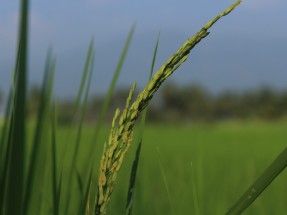New enzyme identified in synthesis of strigolactones in rice
2024-08-29

A team of researchers, including from MiCRop, have identified an enzyme in rice plants which is likely involved in the production of strigolactones (plant hormones which signal underground fungi for mutual symbiosis). This was published in an article today in Science Advances. Plants which had this enzyme removed showed signs of weaker fungal recruitment and malformed root structure. This work expands our understanding of how strigolactones are produced (in rice) and how complex the processes are.
Abstract
Strigolactones exhibit dual functionality as regulators of plant architecture and signaling molecules in the rhizosphere. The important model crop rice exudes a blend of different strigolactones from its roots. Here, we identify the inaugural noncanonical strigolactone, 4-oxo-methyl carlactonoate (4-oxo-MeCLA), in rice root exudate. Comprehensive, cross-species coexpression analysis allowed us to identify a cytochrome P450, OsCYP706C2, and two methyl transferases as candidate enzymes for this noncanonical rice strigolactone biosynthetic pathway. Heterologous expression in yeast and Nicotiana benthamiana indeed demonstrated the role of these enzymes in the biosynthesis of 4-oxo-MeCLA, which, expectedly, is derived from carlactone as substrate. The oscyp706c2 mutants do not exhibit a tillering phenotype but do have delayed mycorrhizal colonization and altered root phenotype. This work sheds light onto the intricate complexity of strigolactone biosynthesis in rice and delineates its role in symbiosis and development.
You can read the full article here
